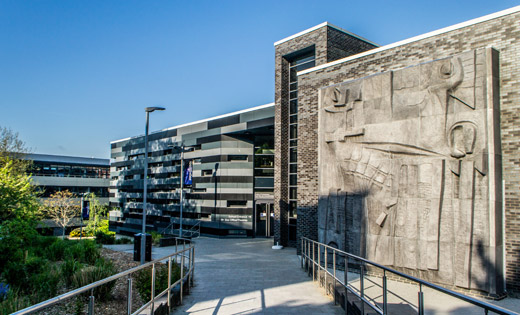Listed sculpture is restored and returned
The University is welcoming back one of its largest pieces of art.

Untitled Bas-Relief, is a 6.4m by 6m sculpture in aluminium by Hubert Dalwood, one of Britain’s leading post-war sculptors.
It was commissioned in 1961 and adorned the building of the University’s Bodington Hall of residence – affectionately known by generations of students as the Bod – for more than 50 years.
The sculpture was greeted with great critical acclaim from The Guardian, The Times and the Yorkshire Post following its unveiling. It features abstract shapes that flow across a grid of 36 rectangular sections and was Grade II listed by Historic England in 2012.
When Bodington Hall, in north Leeds, was demolished in 2013, the sculpture was carefully taken down, conserved and stored, awaiting a suitable new home on campus. It has now been installed on the stage@leeds building, the University’s contemporary performance space.
University Librarian Dr Stella Butler, who oversaw the University’s Public Art Strategy, said: “It’s great to see the Dalwood back in a prominent position on a University building and we are pleased to have been able to find a new home close to the heart of campus where it can be appreciated by students, staff and visitors.”
Hubert ‘Nibs’ Dalwood was awarded a prestigious Gregory artist-in-residence Fellowship at the University of Leeds in 1955 and remained until 1959. It was during this period he first began to work in aluminium. The work at Bodington Hall was his first large scale relief for a University building.
One of Dalwood’s daughters, Kathy Dalwood, herself an artist and a graduate of Leeds College of Art, said: “Growing up in Leeds myself it was wonderful to be able to see the relief whenever I wanted and I was very proud to tell people it had been made by my father. I’m absolutely delighted that his sculpture has been saved, restored and re-installed at the centre of the University for subsequent generations to enjoy and I hope art students and lovers of art will continue to be inspired by it.
“The sculptures my father made during his years in Leeds – thanks to the Gregory Fellowship – were really what launched his career so it was a very important period for him. Receiving the Bodington Hall commission gave him a sought-after opportunity to translate his current ideas to a monumental scale.
“I remember visiting the foundry in Leeds with him and his excitement at seeing his original panels – in clay, wood and plaster – transformed into aluminium. Leeds was an epicentre of contemporary European art at the time, he found it a very stimulating and exciting environment in which to work and was delighted to have such an important sculpture commissioned in the city.”
Eminent art historian Quentin Bell, who was the University’s first Professor of Fine Art from 1959 to 1967, described it as “the largest and I think in every way the most important of Hubert Dalwood's sculptures”, adding: “The University may well be proud to possess such a work, and proud that it is the work of a Gregory Fellow.”
The work will be included in a new version of the University’s Public Art Trail, which guides visitors around its many important artworks. Free copies of the trail will be available next week from The Stanley & Audrey Burton Gallery, and it is downloadable here now. An interactive version of the trail can be accessed by clicking the Art On Campus tab on the campus map.
Posted in: University news